How to carry out the installation correctly?
According to the rules, in any material for sheltering plants, you need to make a hole crosswise - and then plant in it. But the experience of many summer residents shows that it is much more rational to cut a small round hole. After all, the corners often cover the plant, but the hole is easier to bury with earth later.
Correct application:
- Step 1. Level the soil in the beds.
- Step 2. We spread the acquired film next to it on the ground and mark the location of future bushes or seedlings on it.
- Step 3. Using a small saucer and along its edges, cut out circles (or make cross-shaped cuts). The distance between the circles should be about 40-45 cm - or depending on the peculiarities of growing your crop. Just do not plant too close (remember the science of Mittlider), otherwise you will then end up with a thick and poorly ventilated strip.
- Step 4. We spread the roll on the beds and press it along the edges with pebbles.
- Step 5. Place a new plantation in the holes made. You can, however, not cut the holes in the circles in advance, but make cross-shaped holes right on the garden bed - this is already convenient for someone.
If you have any one weed growing, which is unlikely, it will be so weak that you can pull it out without effort. You can feed the plants in the same holes where the strawberry or some other plant is planted.
And here is a detailed instruction on how to get rid of weeds on the path in the greenhouse once and for all:
Step 1. Prepare the necessary tools: board, hand cultivator, wheelbarrow, shovel and scoop.
Step 2. We purchase any inexpensive nonwoven material: spunbond, agrotext, agrospan or geotextile. It is advisable to take black - it is just called "mulching". It will allow water and air to pass through, but not light - and therefore you will not see puddles on the path between the greenhouse beds, but there are more weeds too.
Step 3. We collect mulching substrate: crushed stone, slate, bark, expanded clay, decorative stone or just gravel.
Step 4. Remove the top layer of soil from the track, using a board or plywood for convenience
It is important that the soil surface is strictly horizontal.
Step 5. We compact the path well, and, if necessary, also remove excess soil
The path should be neat.
Step 6. Cover with prepared covering film. Lay the joints with an overlap so that seeds do not accidentally fall into the cracks. If in the greenhouse you have beds, and not boxes, then leave a little allowance on the edges, so that later gravel or something else does not mix with the soil.
Step 7. Fill up the mulching substrate so that its level is level with the ground or slightly lower.
Step 8. Smooth out crushed stone or stones and cut off excess edges.
That's all - now you will forever forget about the problems with the greenhouse path. Clean, tidy and long lasting.
By the way, enterprising summer residents have learned how to build an interesting thing for fixing the film. So, from a thick wire with a diameter of 0.3, we cut several pins 20 cm long, and bend it in a vice. We lay the shelter, and with the same pins we fasten it along the edges. Pieces of wire will easily enter it - even into the thickest non-woven fabric, now nothing will blow off or touch the material, and you no longer need to lay a bunch of stones or bricks. Very convenient and tidy. And in the fall, when the film or non-woven needs to be removed, just take out the pins and hang them on the fence - it's quick.
If the film is handled carefully, then it can be used the next year - planting seedlings in the existing slots. Often they are used in this way: from spring we cover with glassine to drown out all weeds. After - we dig it up, and then we cover it with a film with a density of 70 and lay it in two layers.
Features and structure of the material
As the name implies, the material is called covering for a reason. Moreover, it can be used both for covering the seedlings and crops themselves, and, conversely, for the soil.In the second case, if necessary, certain cuts are made in it, through which cultivated plants germinate.
The main feature is that when using such material, the yield indicators of absolutely all crops increase. And also the covering material greatly facilitates the agricultural labor itself and the process of caring for any cultivated plants. In this case, a special material must be used.
A number of requirements are imposed on him.
- Product color. It should be black or transparent, almost white.
- It should allow air to pass well and a small amount of moisture.
- Be dense enough, but light at the same time.
- Do not contain any harmful substances.
The scope of use of the covering material is quite extensive. It is not surprising, because the facilitation of agricultural labor, even today, in the age of technology, is more relevant than ever.


Alternative to weeding
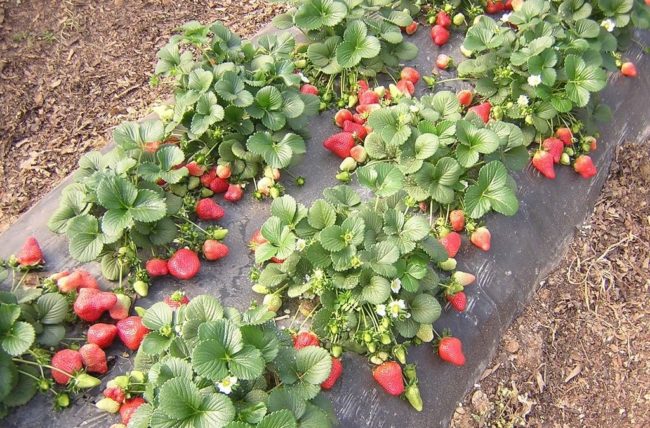
It is more pleasant to look after strawberries growing on a covering material, and the berry does not get dirty from the ground.
Weeding a strawberry plantation is a time-consuming job, and you have to do it several times per season. A convenient solution to this problem has been found: the surface of the land in the garden bed is lined with special materials that suppress the growth of weeds. At the same time, compact strawberry bushes continue their normal development.
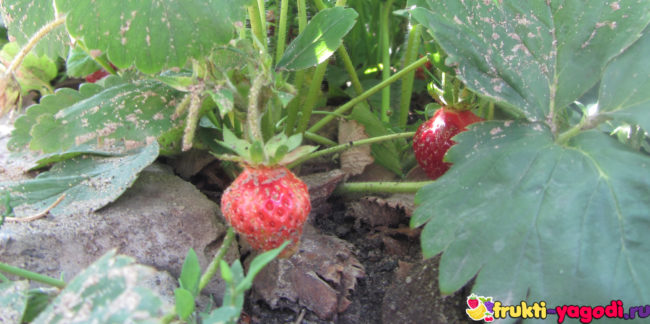
When watering, the soil fell on the strawberry fruits, if mulching had been used, this would not have happened!
What and how to cover the soil? The best material is black agrofibre. In addition, black plastic film, roofing felt, roofing felt, newspapers and pieces of cardboard, a thick layer of straw or other mulch are used for the same purposes.

One has only to start the weeds a little, and one good rain is enough for the strawberries to get stuck in the weeds.
English version (organic mulch)
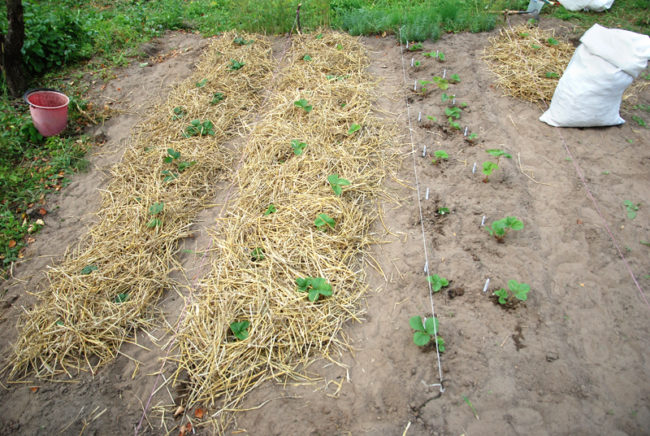
Organic mulch needs to be renewed once or twice a season.
It is known that the British call strawberries "straw berries" because they put straw under the bushes so that the berries do not get dirty from the ground.
Weed seeds, falling on loose mulch, still germinate. Cardboard or newspapers have a denser structure, but they quickly get wet and lose their properties. All these improvised means do not guarantee complete protection of the beds from weeds.
Finnish experience (black polyethylene)

Mulching strawberries with foil is not the best option due to certain disadvantages.
At the same time, young rosettes are planted in small cruciform incisions. This method has shown good results in a northern country like Finland. In Russia, it is still used by some gardeners.
Disadvantages of Finnish technology:
- the film must be of high quality and expensive, otherwise it quickly bursts, collapses;
- the soil does not breathe;
- strawberry roots overheat, rot (hot, condensation);
- it is advisable to lay a drip irrigation system under the film.
Positive aspects:
- no weeds;
- the mustache does not grow, it is convenient to remove them;
- pests (such as weevils) have nowhere to winter;
- the berry is clean (no dirt and rot);
- it is convenient to harvest the crop;
- heat accumulates and fruiting is accelerated.
Black agrofibre

It is convenient to work with a covering non-woven material and it serves for a long time.
Weed control mulching fabric has additional valuable qualities:
Varieties of black covering material
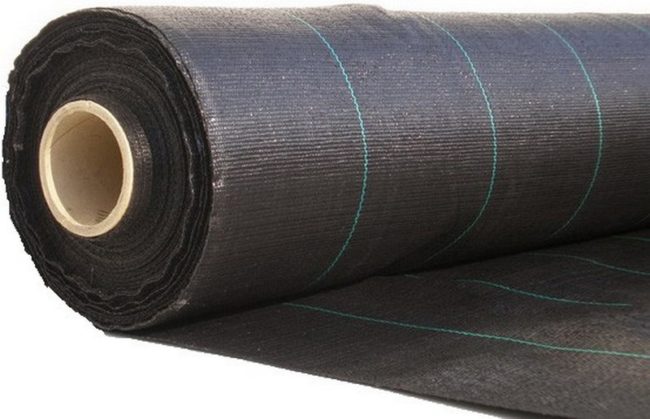
All covering materials are united by the ability to pass moisture and air.
Agrofibre from various manufacturers is produced using a similar technology. Names may differ for different brands:
- Agril,
- Spunbond,
- Agrolux,
- Agrotex,
- Greentex,
- Lutrasil,
- Agrospan.
In recent years, a two-layer version (white-black or yellow-black Agrotex) has become widespread. The lower black side prevents weeds from growing, and the upper light side protects the roots and the aerial part of the bush from overheating.Two-layer Agrotex is convenient to use on hot southern slopes, in greenhouses and greenhouses, in southern regions.

The outer white layer of Agrotex saves from overheating, and the inner black layer absorbs sunlight and keeps weeds.
What is a covering material for weeds for?
Covering material, as a method of weed control, has appeared relatively recently, but gradually it is this tool that is becoming the most popular. This is due to the numerous advantages of such a material.
First, it protects crops from weeds and pests. Secondly, under the shelter itself, a favorable environment is created for the development of cultures. Thirdly, the covering material is easy to use, and even a novice gardener can lay it out in the beds.
It should also be noted the low cost of such products. Even if you want to cover your entire vegetable garden with agrofibre, it will cost you less than buying insecticides and herbicides to spray your plants.
 Figure 1. Popular types of covering material
Figure 1. Popular types of covering material
The principle of operation of all types of covering material is quite simple. A black film or agrofibre is laid out on the bed, and then cross-shaped holes are made through which crops will germinate (Figure 1). The film must be fixed so that the wind does not rip it off. You can simplify the task a little: first, plow the garden, and then spread agrofibre or film over it. When the time comes to plant the plants, the required number of holes is made in the coating and the planting is carried out directly into them. However, it should be borne in mind that this method is only suitable for planting seedlings or berry crops.
Many summer residents doubt whether the plants will develop more slowly if the entire bed is completely covered with a film or cloth. It is worth noting that it is this method of weed protection that is used when organizing beds according to the Mitlider or Lyadov method.
You can verify the effectiveness of the covering material as a method of weed control by evaluating its advantages:
- All modern types of garden bed coverings are produced using modern technologies. This completely eliminates the risk of rot or mold formation under the shelter.
- Such a cover for the beds creates optimal conditions for seed germination, as well as the growth and development of young plants.
- Black film or agrofibre is recommended for use in regions with cool climates. When heated, such products will also increase the temperature of the soil, which will have a beneficial effect on the rate of seed germination. Moreover, if black material is used in warm climates, an additional layer of hay or sawdust should be laid on top of it so that young plants do not overheat and die.
- All types of covering material have increased strength and resistance to mechanical damage. However, to prevent it from being blown off by the wind, the film or fabric must be fixed on the ground surface.
- The very structure of the material perfectly protects young tender plants from direct sunlight, which can provoke a burn. At the same time, air, heat and moisture freely penetrate inside.
When growing seedlings and strawberries, a film is often used, which completely covers the entire garden, and the plants are grown in small holes. This method has several advantages at once. Firstly, weeds do not germinate under the film, and the grass that appears quickly dies due to the lack of sunlight. Secondly, strawberries grown on film are not contaminated with soil, but the bushes themselves receive a sufficient amount of moisture and nutrients.
In addition, there are white, transparent and colored nonwovens on the market. They can be used to cover the beds after the seed has been sown.Under such a fabric, optimal conditions are created for seed germination, since a sufficient amount of heat, air and moisture gets under the shelter. In addition, such a canvas prevents soil weathering and evaporation of moisture from the soil, which greatly facilitates the care of crops. Watering and applying liquid dressings in this case is also considered simple, since the liquid can be simply distributed over the surface of the canvas
Types of covering material
Agricultural weed cloth on the market comes in several popular varieties. Products differ in density, color and manufacturing method. The characteristics of the nonwoven fabric are selected individually for the needs of the farmer.
Spunbond
A covering fabric made of polypropylene fibers is created using a special technique. A durable and wear-resistant coating is not afraid of ultraviolet radiation, precipitation and temperature extremes. Raw materials are used both in the open field and in greenhouses. Spunbond from weeds with a density of 50 g / m2 inhibits the growth of harmful vegetation, protects it from frost. In regions with cold climates, an option from 60 to 80 g is suitable.
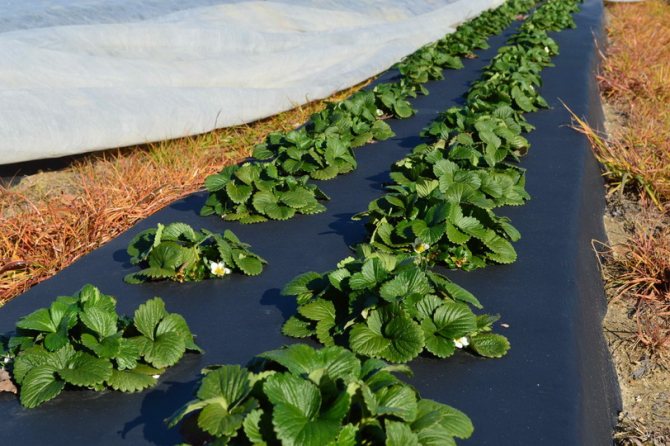
Two-layer covering material is used as mulch and protection against negative weather conditions. The light layer neutralizes excessive sun exposure and prevents plantings from overheating. The lower tier suppresses the development of weeds. Reinforced models with increased strength can be used to create paths in the garden, vegetable garden.
White fiber with a density of 17 to 40 g / m2 transmits light, maintains an optimal microclimate, and therefore is only suitable for arranging greenhouses. Spunbond is not afraid of temperature fluctuations in the range from +100 to -50 ° С. Weed products do not react with chemicals and do not emit toxins.
How to use?
The application of the black covering material can be different. Users can lay it both in the country and in the garden. Let's consider the most popular applications:
- frame;
- frameless;
- mulching.
In the first case, the material is stretched over a specially prepared frame. The purpose of the greenhouses is to warm up the soil as early as possible so that seedlings can be grown in it. The canvas should be quite dense, as it will be subject to a significant load in the form of precipitation, wind and a drop in temperature. However, at the same time, sufficient humidity and the necessary temperature regime must be maintained inside the greenhouse or greenhouse for the plants to grow and develop more actively.
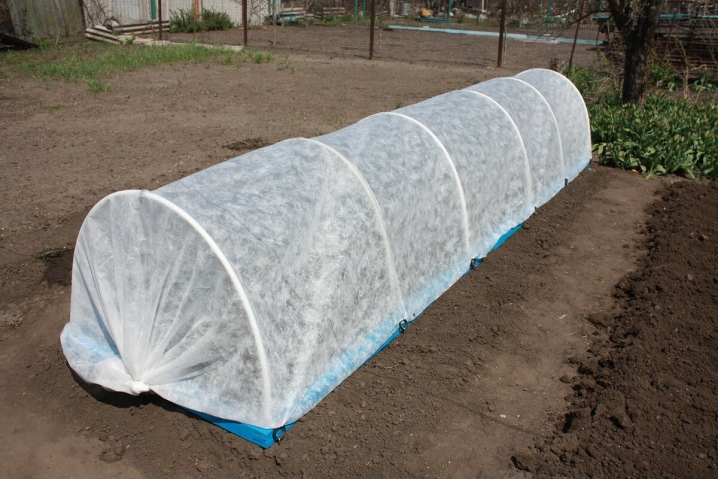
A frameless method is assumed when you need to warm up the earth and hide the seedlings from sunlight. For this, a material that is not too high density is quite suitable. The soil is covered immediately after the seedlings are planted. Such a canvas will allow air and water to pass through, but at the same time provide protection from sunlight. Since it does not weigh too much, the seedlings in the process of growth will be able to calmly pick it up without breaking.
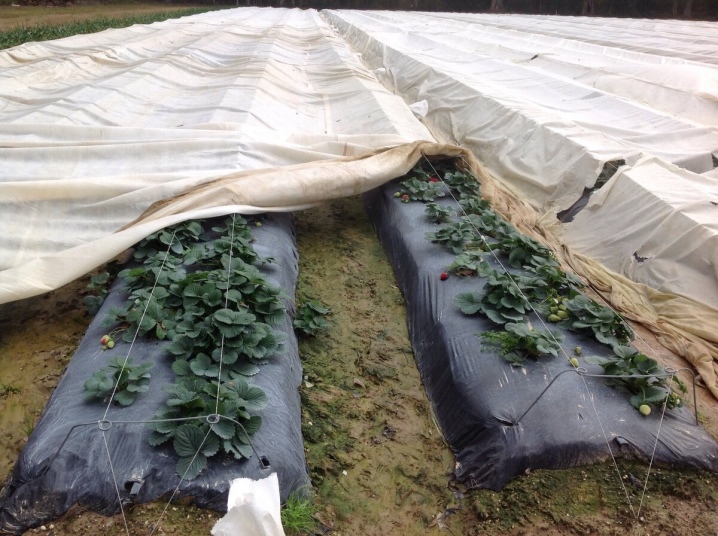
Any of these nonwoven fabrics can be used for mulching. In this case, the soil will not overheat and dry out, and weeds will no longer actively grow. Since water and dirt do not get under the canvas, the fruits remain clean and do not rot. The microclimate is optimal for planting to develop correctly.

Covering material must be laid on a bed prepared in advance. Further, cross cuts are made along the marks. Seedlings are planted in these places. It should be noted that in this case, the seedlings will not require frequent watering and weeding. The harvest will be plentiful and of high quality.
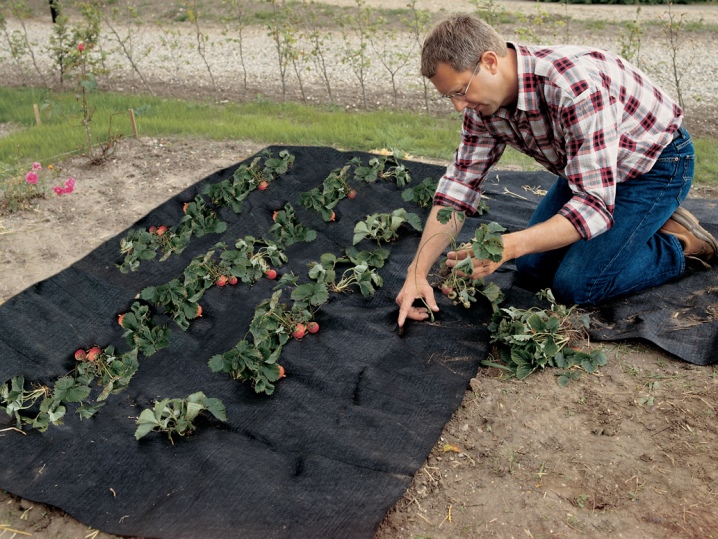
For the use of covering material in the summer cottage, see below.
Making a track
Agrofibre will help get rid of weeds not only in the garden, but also on the paths of the plot or in the garden. First, let's prepare all the necessary tools for this.Then, you should purchase any of the inexpensive nonwovens, but preferably black. It transmits air and water well, but does not transmit light, so at the end of the work on your paths you will not have to see any weeds or puddles. Now we proceed to the arrangement of the tracks. To do this, we prepare a substrate that serves as mulch for paths: crushed stone, expanded clay, gravel, stones.
Now remove the top layer of soil from the tracks. It is necessary to ensure that the surface of the earth is strictly horizontal.
Then, carefully ram the path. If necessary, we remove excess soil, then the path will turn out to be smooth and neat.
Now we spread the prepared black film along the path. The joints must be overlapped so that seeds cannot penetrate into the cracks. If in your greenhouse where strawberries and other crops grow, beds are arranged instead of boxes, then you need to leave some material for allowances on the edges. This is done so that rubble or other mulching substrate does not mix with the ground.
After that, we put crushed stone or any other substrate that you prepared for mulching on the path so that it is level with the ground, or slightly lower. We level the crushed stone and remove the excess material sticking out from under the substrate.
That's it, the work is over, the track will look clean and neat for a very long time.
Covering material weed control
Despite the fact that people got acquainted with modern covering materials much recently, every year more and more owners of summer cottages and vegetable gardens use them on their site. They are attracted by the fact that with the help of these materials, which are easy to use, it is possible to create favorable conditions for the growth and development of plants. And the most important thing here is that they perfectly protect garden crops from weeds and pests.
Today, in stores for summer residents, you can buy a large number of options for mulching canvases, however, the most popular among such solutions that allow you to control weeds is a black covering material based on agrofibre with a density of 50-60 g / m2.
Operating principle
You can make sure that such canvases are easy to use by familiarizing yourself with the principle of their work.
- the black cloth acquired in advance is pulled onto the surface of the seedling beds, and then cross-shaped cuts are made in it in those places from which the seedlings will grow;
- the procedure for preparing the material may be somewhat different: after the earth is covered with a covering material, holes are made in it, into which the seedlings are then planted directly or seeds are sown.
Advantages
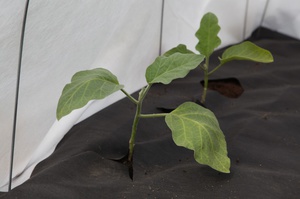
Mulched beds
- Such canvases are made using the latest technologies, which excludes the formation of rot and mold under them. At the same time, they create optimal conditions for plants to be supplied with all the substances necessary for their normal growth.
- When using black mulch in hot southern regions, it is recommended to lay hay on top of it, since on very hot days the plants can easily burn out, and the canvas will lose its performance.
- One of the significant advantages of black covering material is its high strength.
- The color of such canvases protects from sunlight, at the same time heat, moisture and air pass well through the material.
- The film covers the weeds, preventing them from reaching the sunlight, and this inevitably leads to depletion and death of young grass shoots.
The use of white, transparent or colored covering material allows you to create the most favorable conditions for plants, providing them with the necessary amount of light, air and moisture. Therefore, having such a shelter at your disposal, you do not have to spend a lot of time and effort in order to get a rich and healthy harvest.
Such canvases protect the earth from weathering and do not allow moisture to quickly evaporate.This, in turn, eliminates the need for the owner to carry out such tedious operations as weeding and loosening the soil. It seems quite convenient to water and apply liquid mineral fertilizers for plants that grow under such a covering material: water and fertilizing can be poured directly over the canvas.
In addition to this, with the help of such a shelter, you can provide the beds with a well-groomed and neat look.
It is equally important that non-woven materials do not harm the soil and plants, since they are completely environmentally friendly.
Recent Entries
Chainsaw or electric saw - what to choose for the garden? 4 mistakes when growing tomatoes in pots that almost all housewives make Secrets of growing seedlings from the Japanese, who are very sensitive to the earth
Rules for the use of covering material
It is very important to clear the land of weeds as much as possible. For this, various methods are used: they keep the territory under steam or green manure for a year, use herbicides, carry out a deep digging

A place for strawberries is prepared in advance - green manures are planted, brought to flowering and embedded in the ground.
The soil is dug to a depth of 30-40 cm, carefully choosing the roots of the weeds. The soil is well fertilized. One square meter of future plantings is made:
- 10-15 kg of well-rotted humus or compost,
- a half-liter can of wood ash,
- humates with trace elements (according to the instructions for packaging),
- 20-30 grams of potassium sulfate,
- 40-50 grams of superphosphate.
Potassium and superphosphate can be replaced with a complex mineral or organomineral fertilizer (OMU), which is better specialized for strawberries.
The beds are poured higher if the groundwater is close. In other cases, they are only slightly raised or made flush with the ground. Then the soil must be leveled. Before covering with agrofibre, the soil should be given time for a slight settling (15-30 days).
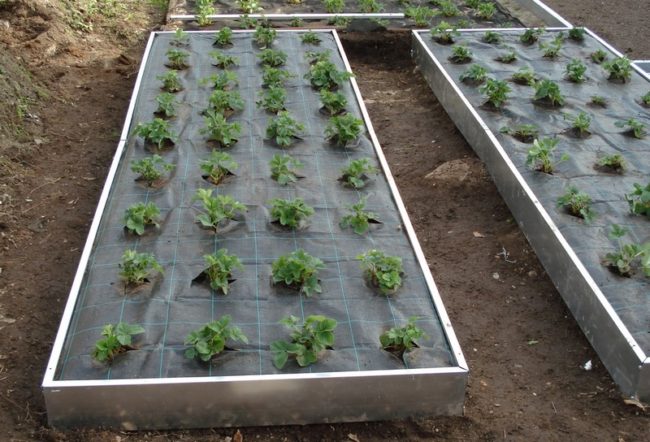
High bed for strawberries from boards.
How to grow cucumbers under the covering material
This garden crop grows well in warm conditions with sufficient, but not too much, sunlight. It is difficult to grow a good harvest of cucumbers. In early spring, these plants can die from frost. In the summer they suffer from extreme heat and lack of moisture. There are also many types of insects and microorganisms that can harm cucumbers.

To cover the cucumbers on top, it is recommended to use PVC film, polyethylene or white spunbond
Appropriate protective materials will help to solve all the listed problems. For shelter from above, use ordinary or bubbled polyethylene, as well as PVC film. There are also reinforced versions of such canvases - to give them greater strength. As a top cover for cucumbers, you can use white spunbond or its analogue of low density - about 28 g / m² (the same density is also suitable for tomatoes).
The advantage of the latter option is the ability to water the seedlings from above. The liquid will seep directly through the fibers of the material. In addition, agrofibre traps ultraviolet rays, redirecting only the soft part of the sunlight spectrum to the cucumber seedlings.
The best option for laying the ground in the garden is non-woven agrofiber. This black weed cover material has several advantages. It is easy to make holes in it. Through them, plants are watered and fertilized (as a rule, with rotted foliage, compost or manure). At the same time, moisture practically does not evaporate from the soil, which means that watering cucumbers can be carried out much less often. The access of insect pests to plant roots will be significantly hampered.

White spunbond allows you to water cucumber seedlings from above, and it also lets in the sun's rays
The optimum temperature for growing cucumbers is 20 ° C during the day and a few degrees lower at night.The use of covering materials allows you to maintain the required temperature directly in the open air, without placing plants in greenhouses.
When using agrofibre, it is enough to moisten cucumbers only twice a week (after planting in mid-spring). The best way to fertilize is by sprinkling with sodium humate dissolved in clean water. Concentration - one spoonful of ingredient per bucket.
